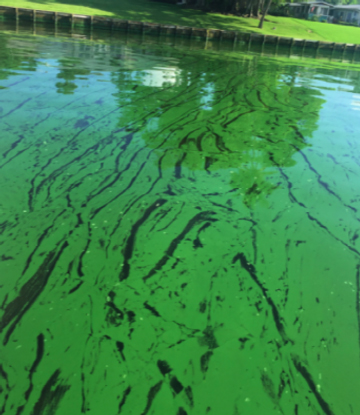Killer Waters: The Dangers of Blue Green Algae for Dogs
Aug 22, 2019Did you know that our four-legged friends are at an increased risk of becoming ill from blue green algae (a.k.a. cyanobacteria)? This risk is due to the way they interact with bodies of water such as lakes, rivers, and ponds. Between drinking water while swimming, jumping fully in during play, and licking water off their bodies and paws, they have a much higher chance of accidentally ingesting algae that may be harmful to them.
When ingested, the effects on people and animals from this alga can range from as mild as skin irritation to death. Recently, 3 dogs in North Carolina and 1 in Georgia died after swimming in ponds that were suspected to contain these cyanobacteria. These are not the only deaths in recent years from suspected poisoning either, suggesting people should use extreme caution when deciding to take their two and four-legged family members to the local pond for a swim.
These toxic blue-green algae blooms are not a new phenomenon, especially in the Great Lakes area. Lake Erie experiences one of the largest algae blooms in the area almost every year, starting from about July until early fall. In 2017, the bloom was so large it covered several miles and could be seen from space! This blue-green alga that causes blooms is actually a form of bacteria, “cyanobacteria” which can sometimes produce toxins known as “cyanotoxins” during photosynthesis that can act as a neurotoxin or hepatotoxin to people and animals, damaging the liver and nervous system. While not all will produce anything that can hurt you or your pets, there’s no way to tell which ones do, and which ones don’t. Some cyanobacteria blooms will appear as spilled green paint, scum, or “pea soup”, but others can not be detected by the naked eye.
Peak levels of cyanotoxins usually occur in August when conditions are most optimal for algal growth. Warm weather, shallow and stagnant water, high amounts of runoff after a rainfall event, and presence of invasive species such as zebra or quagga mussels all can contribute to the growth of toxic algae in the bodies of water we swim in. The record warm weather in recent years has produced the perfect conditions for cyanobacteria to bloom. The EWG stated on their website that in 2018, Illinois was among those states tested for microcystins that consistently came up positive in multiple water samples. What all this means is that while all ponds and lakes in Illinois are most likely safe, there is a reasonable chance they may not be due to current weather conditions.
At this time, for you and your pets’ safety, we recommend staying out of any bodies of water if there is any suspicion that there could be harmful algae in the water or along the shoreline. In addition, rivers are less likely to be affected, but can still contain toxic algae. If you suspect you or your pet may have been exposed to a toxic variety of blue-green algae please rinse you and your dog off immediately with clean water and go immediately to your nearest emergency vet. Death can occur within hours so timing is of utmost importance. While everyone should remain vigilant in these last warm weeks of summer, we also encourage you to still go out and have fun. Just maybe consider going to the pool to cool off instead of visiting your local pond and keep a sharp eye out!
Wild Goose Chase uses border collies for goose management and we do not allow our dogs to swim in ponds, lakes, or other bodies of water. During this time of year, you may see that our working dogs are kept on leashes more often to help keep them away from blue green algae. Rest assured, even when they are working on leashes their stalking and chasing techniques are still effective in moving geese off of properties.



 0
0
